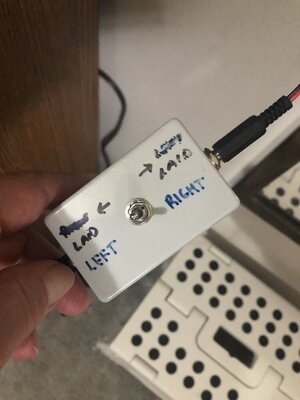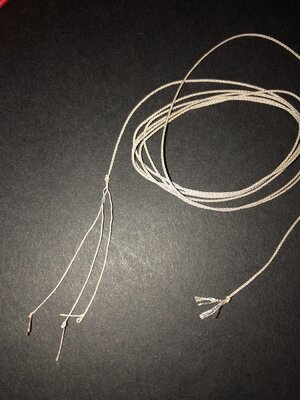OK. I put a reversing switch on my rope walk so now I can mark them Z and S
-

Win a Free Custom Engraved Brass Coin!!!
As a way to introduce our brass coins to the community, we will raffle off a free coin during the month of August. Follow link ABOVE for instructions for entering.
-

PRE-ORDER SHIPS IN SCALE TODAY!
The beloved Ships in Scale Magazine is back and charting a new course for 2026!
Discover new skills, new techniques, and new inspirations in every issue.
NOTE THAT OUR FIRST ISSUE WILL BE JAN/FEB 2026
You are using an out of date browser. It may not display this or other websites correctly.
You should upgrade or use an alternative browser.
You should upgrade or use an alternative browser.
Whenever I use single lines per hook ( for Z laid) then yes they have to be unwound then rewound which is why they grow then shrink. Stephens correct when you run more than one line per hook then that process can not happen. In either case for Z laid the gears need to run counterclockwise to make the threads spin clockwise thus producing right hand twist. All of my source threads are manufactured as right lay. Again I do not understand every thing I know about this but as long as the end product looks good it doesn't matter.Have you had any complications with having to twist it backwards. I noticed when I was twisting a single thread backwards that it got longer and then shortened up as you would expect.
- Joined
- Aug 8, 2019
- Messages
- 5,504
- Points
- 738

With a single line on one hook I make it lefthanded. With serafil you need indian eyes to see the difference between left or right. What can be see is that when righthand twisted in that case the rope is not equal turned on the lenght. That's why I make an exception for that case. And it confused me indeed too. That's why I made notes on my ropewalk to don't forget or get it wrong.Whenever I use single lines per hook ( for Z laid) then yes they have to be unwound then rewound which is why they grow then shrink. Stephens correct when you run more than one line per hook then that process can not happen. In either case for Z laid the gears need to run counterclockwise to make the threads spin clockwise thus producing right hand twist. All of my source threads are manufactured as right lay. Again I do not understand every thing I know about this but as long as the end product looks good it doesn't matter.
I like my serving tool reversable switch better because its variable control in either direction. I think that is called 'rheostat' or something like it.I used the elektronica left right unit of Aliexpress, I mentioned in the partslist of my serving tool. Same thing.
- Joined
- Jul 27, 2021
- Messages
- 412
- Points
- 323

One of the major sources for misunderstanding in rope making imo is the wording
"Laid Right" and "Laid Left" is the most problematic way to say. What is meant? The resulting rope, or the direction the ropewalk is turning? From wich viewing angle? In front or back?
The best and safest way is to talk of Z- and S-Laid in combination with right handed or left handed as the thumb of the hand is showing the direction of the rope lays. Even hawser & cable laid leads to misunderstandings because Americans mixed it up around 1847.
"Hawser-laid and Cable-laid are the same" Source: William Brady, The Kedge
 , 1852 -> What is simply wrong.
, 1852 -> What is simply wrong.Dirk
My rope walk is made from an old sewing machine. Since it was an AC motor I was unsure about reversing the direction. I Googled "reversing a sewing machine motor" and found that sewing machine motors are AC/DC motors and they are reversible. You just have to reverse the wiring on either the commutator or the armature. So I wired the commutator out to a DPDT switch and now it goes both ways. I'll probably only use it for single thread per hook like Stephan but you never know. I guess I can use it for cable.
Thanks for all the help.
Oh, Daniel do you use Serafil 300 tex 10 for all your ropes? I can see that larger diameters would need LOTS of strands.
Thanks for all the help.
Oh, Daniel do you use Serafil 300 tex 10 for all your ropes? I can see that larger diameters would need LOTS of strands.
Don,My rope walk is made from an old sewing machine. Since it was an AC motor I was unsure about reversing the direction. I Googled "reversing a sewing machine motor" and found that sewing machine motors are AC/DC motors and they are reversible. You just have to reverse the wiring on either the commutator or the armature. So I wired the commutator out to a DPDT switch and now it goes both ways. I'll probably only use it for single thread per hook like Stephan but you never know. I guess I can use it for cable.
Thanks for all the help.
Oh, Daniel do you use Serafil 300 tex 10 for all your ropes? I can see that larger diameters would need LOTS of strands.
I use several sizes of source threads. Gutermann Tera 40, and Tera 80. Serafil 300 tex 10, and 20 tex 135. Amann Group strongbond tex90.
Look at my post #86.
Oh yeah, now I remember. This old brain ain't much good any more 

- Joined
- Aug 8, 2019
- Messages
- 5,504
- Points
- 738

Good advise to talk only about S or Z laid. And yes hawser or cable are the same, a mistake often make.One of the major sources for misunderstanding in rope making imo is the wording
"Laid Right" and "Laid Left" is the most problematic way to say. What is meant? The resulting rope, or the direction the ropewalk is turning? From wich viewing angle? In front or back?
The best and safest way is to talk of Z- and S-Laid in combination with right handed or left handed as the thumb of the hand is showing the direction of the rope lays. Even hawser & cable laid leads to misunderstandings because Americans mixed it up around 1847.
"Hawser-laid and Cable-laid are the same" Source: William Brady, The Kedge, 1852 -> What is simply wrong.
Dirk
- Joined
- Jul 27, 2021
- Messages
- 412
- Points
- 323

And yes hawser or cable are the same, a mistake often make.
Ähh no
cheers
Dirk
- Joined
- Aug 8, 2019
- Messages
- 5,504
- Points
- 738

Hawser, I got a problem with this English name, is rope made of 4 ropes? It's like Paul said. This is not my native language. And cable could be made out of 2 or more ropes. What is the difference.Ähh noHawser and Cable are NOT the same ;-)
cheers
Dirk
- Joined
- Jul 27, 2021
- Messages
- 412
- Points
- 323

I really suggest reading my paper (link above) as it explains everything in words and pictures But I can explain here later too, short of time right now.Hawser, I got a problem with this English name, is rope made of 4 ropes? It's like Paul said. This is not my native language. And cable could be made out of 2 or more ropes. What is the difference.
Dirk
- Joined
- Jul 27, 2021
- Messages
- 412
- Points
- 323

Hawser is the "standard" rope made from three Z-Laid strands, a Cable is made from three (rarely more) hawser laid ropes, laid in the opposite direction so S-Laid. Cables were made just because at these times it were technically not possible to do hawser laid rope bigger then 9 inch circumference.
This is a bit simplified but more can be read here: https://forum.dubz-modelling-world.com/thread-41-post-438.html



A
This is a bit simplified but more can be read here: https://forum.dubz-modelling-world.com/thread-41-post-438.html


A
Can you see any difference between Hawser and Cable other than the twist direction?
- Joined
- Jul 27, 2021
- Messages
- 412
- Points
- 323

Can you see any difference between Hawser and Cable other than the twist direction?
A cable is made from three hawsers so, 3 x 3 Strands = 9 strands. So visual it is very different

Please check also the image by Daniel and the drawing above
cheers
Dirk
- Joined
- Aug 8, 2019
- Messages
- 5,504
- Points
- 738

I really suggest reading my paper (link above) as it explains everything in words and pictures
Why talk about hawser rope when it's just rope, Z-twist. I like to keep things simple.
And for the Flemish People cable of 4 Hawser ropes is very common.
To me I can see a big difference between a standard S laid rope and a cable-laid rope. The 'strands' of a cable-laid rope are Z laid. Then take at least three of those Z laid ropes and twist 'them' into an S laid rope. As a side note early on when I started making rope, I made only S laid standard rope and found that using polyester source thread, the rope had an unnatural spotty sheen appearance to it which when compared to Z laid, looked awful. I've added some comparison photos you can see for yourself. Also in this example 3x3 meant 3 source threads (one per hook on machine end) and brought together at the weight at the bottom. All three threads could be spun as independent. Since each source thread had three yarn threads I thought the setup was a 3x3.Can you see any difference between Hawser and Cable other than the twist direction?





